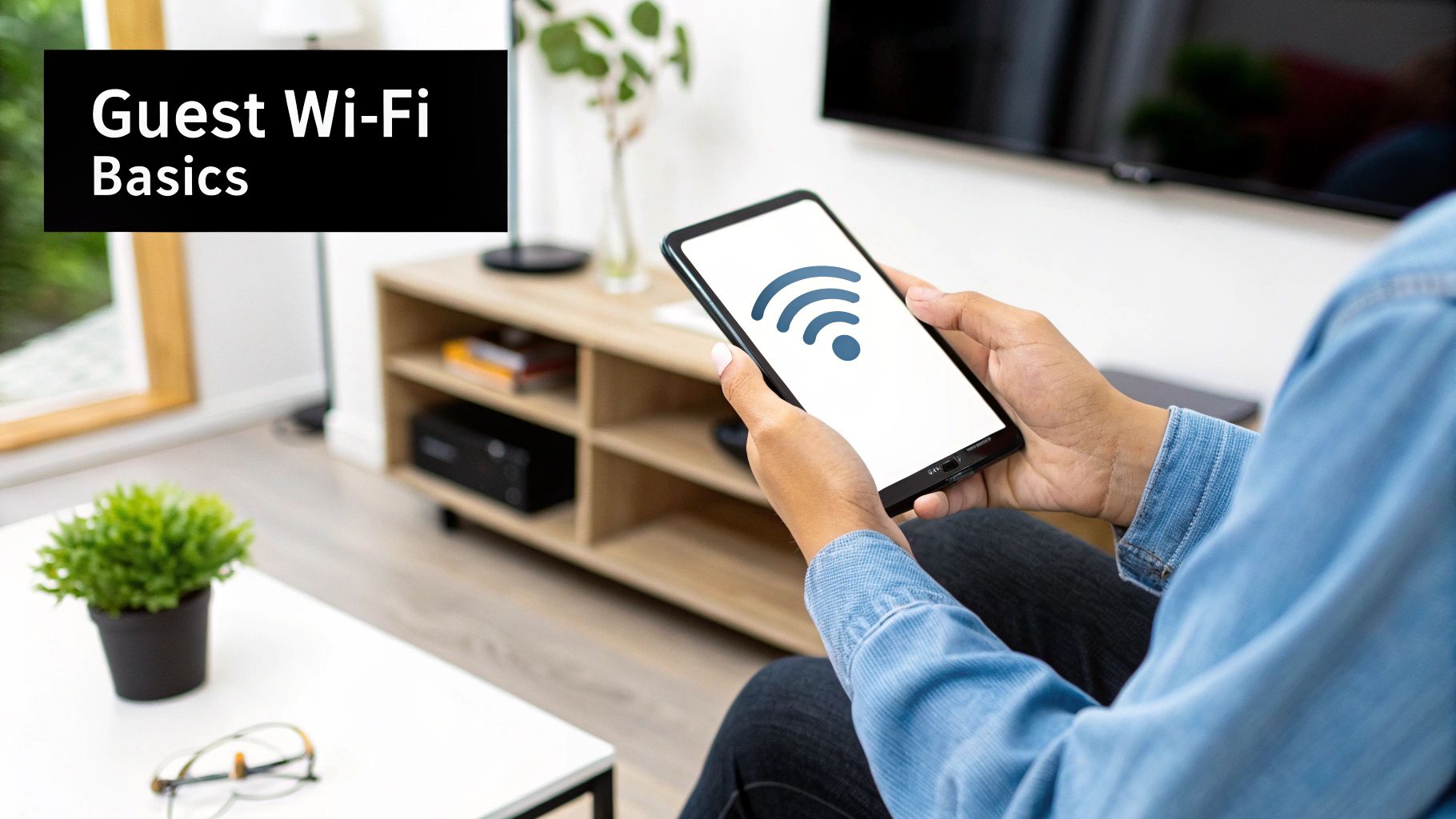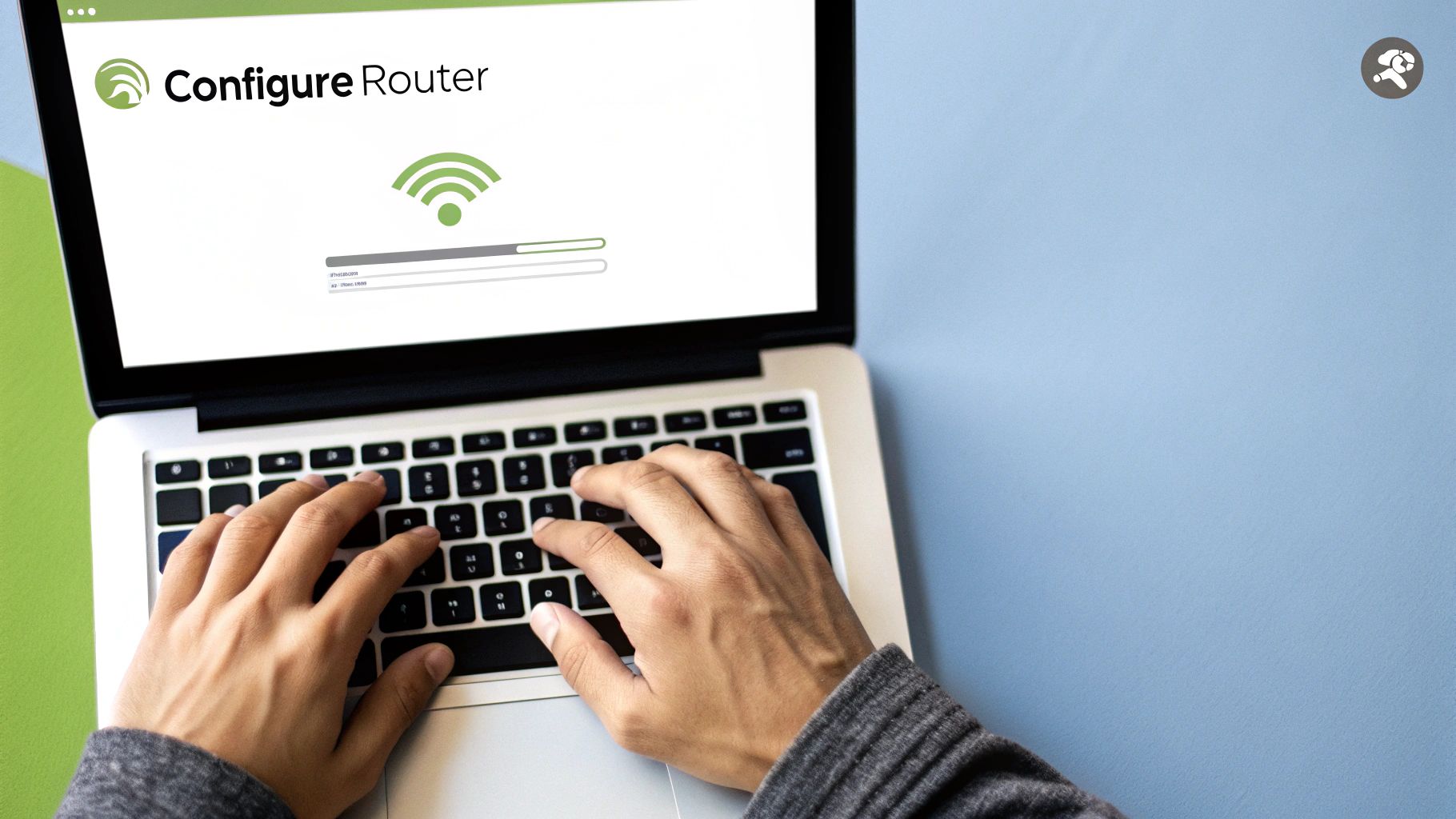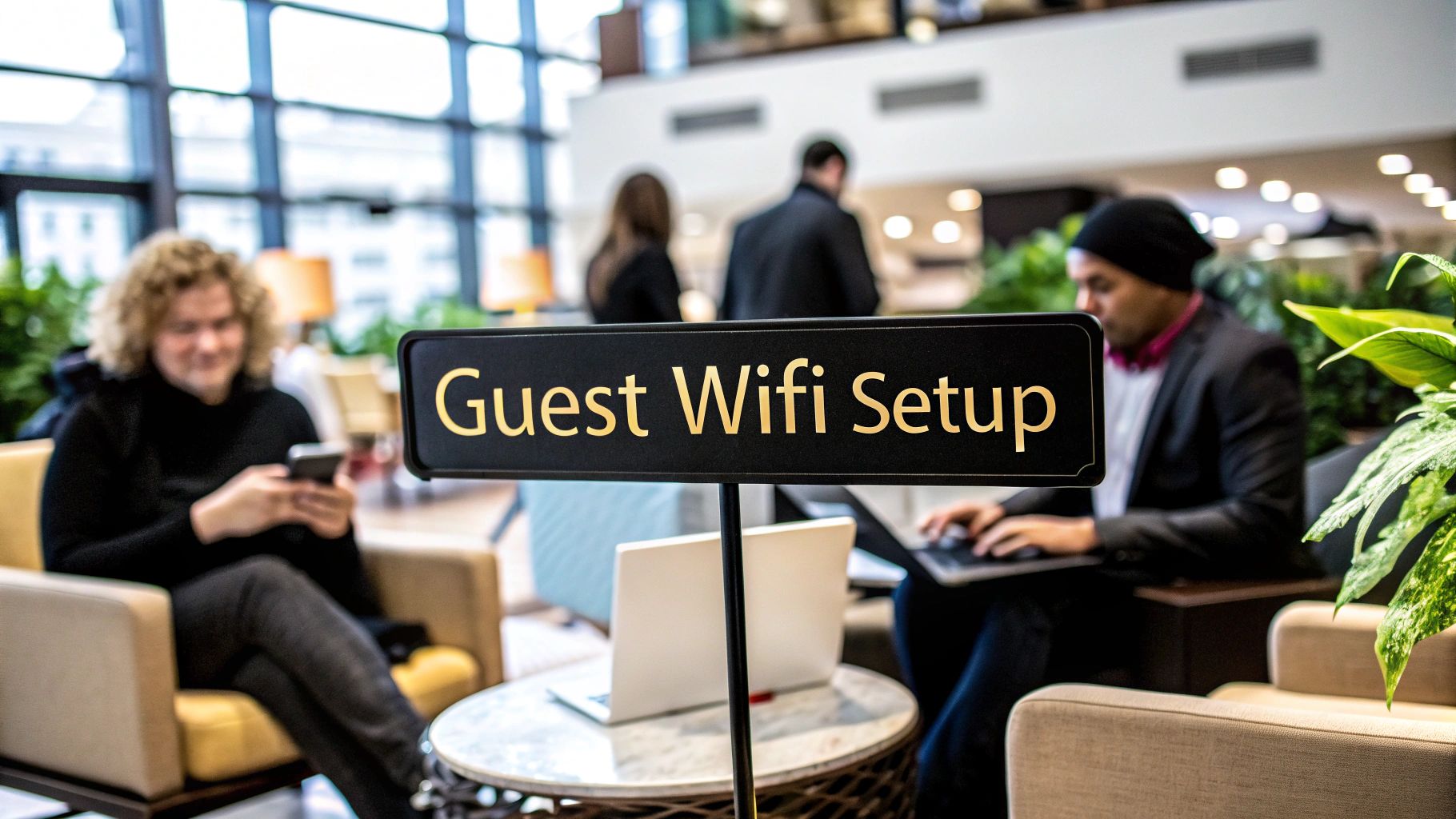When you’re looking to set up guest Wi-Fi, the core idea is to create a completely separate, isolated network just for your visitors. This keeps your private business data safe while still offering a great perk.
For a basic setup, you can often just enable the “Guest Network” feature on your router. This will create a new network name (SSID) and password for your guests. But if you’re serious about security and performance—and you should be—a dedicated access point with a VLAN configuration is the way to go.
Why a Separate Guest WiFi Is a Business Essential

In any commercial or hospitality setting, from a coffee shop to a corporate waiting room, offering internet access isn’t just a nice-to-have anymore. It’s a core expectation. Your customers, clients, and guests all anticipate being able to connect easily. Not providing this can sour their entire experience with your business.
But here’s the catch: just handing out the password to your main business network is a huge security blunder. Think about it. That single network likely connects your point-of-sale systems, private servers, and all your employee devices. A single compromised phone or laptop from a guest could become an open door for an attack on your critical infrastructure.
The Two Critical Jobs of a Guest Network
This is precisely why a dedicated guest network is non-negotiable. When set up correctly, it accomplishes two crucial tasks at the same time:
- Elevates the Customer Experience: It delivers the fast, reliable internet people expect, which can improve satisfaction and even encourage them to stay longer and spend more.
- Shields Your Business Assets: It builds a digital wall, completely isolating guest traffic from your internal network. This is fundamental to safeguarding sensitive company data.
This separation is the cornerstone of secure guest Wi-Fi. It ensures the convenience you offer visitors never jeopardizes your own operational security. As you think about your setup, always keep security and user experience as your twin priorities. If you want to dive deeper into fortifying your digital defenses, our guide on how to strengthen network infrastructure and security is a great next step.
The demand for public internet access is growing rapidly. The global guest Wi-Fi market was valued at $2.5 billion in 2023 and is on track to nearly double to $4.9 billion by 2032. This isn’t just about being nice; it shows how Wi-Fi has become a strategic tool for businesses.
Planning Your Guest Network for Peak Performance

A great guest network doesn’t happen by accident. I’ve seen countless businesses install powerful hardware only to end up with frustrated customers and constant complaints. The real secret to success lies in the planning you do long before plugging anything in. A solid strategy is what separates a valuable amenity from a technical headache.
This all starts with getting to know your physical space. Seriously, grab your smartphone and do a “Wi-Fi walk” through your location. Whether it’s a small cafe, a large hotel lobby, or a multi-floor office, this simple act is your first, most important diagnostic tool. As you move around, pay close attention to the signal strength in areas where guests will actually be.
Assess Your Physical Environment
Keep an eye out for dead zones—areas where the signal suddenly drops or disappears entirely. I’ve found these are almost always caused by physical obstacles that get in the way of Wi-Fi signals.
You’d be surprised by what can interfere. The most common culprits I run into are:
- Structural Elements: Think thick concrete walls, steel support beams, or even elevator shafts. They’re notorious signal killers.
- Large Appliances: In a restaurant or cafe, commercial-grade refrigerators, freezers, and microwaves can wreak havoc on your signal.
- Mirrors and Aquariums: It sounds strange, but big reflective surfaces and even large tanks of water can bounce and disrupt Wi-Fi signals in unexpected ways.
Pinpointing these problem spots from the get-go helps you figure out the smartest places to install your wireless access points (APs). The goal is simple: provide strong, consistent coverage everywhere a guest might need it. This proactive step helps you design a network that just works, avoiding those frustrating disconnects right from the start.
Estimate Your Bandwidth Requirements
With the physical layout mapped out, it’s time to think about speed. How much internet bandwidth do your guests really need? The demands of a small law office waiting room, where a few people might check email, are worlds apart from a bustling coffee shop where 50 people could be streaming HD video at once.
Consider your peak capacity. How many guests will be connected during your busiest hours, and what will they be doing online? As a rule of thumb, I always recommend allocating at least 5-10 Mbps per active user to ensure a smooth, modern web experience. Skimping on bandwidth is one of the most common and damaging mistakes; it leads to a sluggish network that reflects poorly on your entire business.
Here’s a critical piece of advice I always give my clients: Your guest traffic should never interfere with your core business operations. A full house of guests streaming video cannot be allowed to slow down your point-of-sale system or your staff’s computers.
This is why network isolation is non-negotiable. Proper planning means building a digital wall between your guest network and your private, internal network. It’s not just for security—it’s for performance. By dedicating specific bandwidth and rules to guest traffic, you guarantee your business-critical systems always have the speed and priority they need. It’s a foundational step that protects both your operations and your reputation.
Alright, let’s get into the nuts and bolts of setting up your guest network. We’ve moved past the planning stage, and now it’s time to roll up our sleeves and build that secure, separate digital space for your visitors. This is arguably the most important part of the whole process—getting the technical side right is what protects your business while you offer this great amenity.
The very first thing to do is give your guest network its own identity. You’ll do this by creating a new SSID (Service Set Identifier). In plain English, that’s just the name people will see in their phone’s list of available Wi-Fi networks.
So, if your private office network is named “BizCo_Private,” you’ll want to create a new one called something like “BizCo Free Guest WiFi” or “The Corner Cafe – Free Internet.” Make it obvious and welcoming.
What is Network Isolation and Why Does It Matter?
Once you’ve got a name picked out, the single most critical setting you need to find and enable is network isolation. Your router’s manufacturer might call it something slightly different, but you’re usually looking for terms like AP Isolation or Client Isolation.
Seriously, don’t skip this. Finding and flipping this switch is non-negotiable for a secure guest network.
When you turn it on, you’re essentially building a digital wall around every single device that connects to the guest network. This wall prevents them from seeing or talking to:
- Any device on your main business network (your file servers, office printers, and especially your point-of-sale systems).
- Any other guest’s device that’s also on the network.
This is a huge security win. It means if one guest happens to have a virus on their laptop, it can’t spread to other customers. More importantly, it can’t be used to try and poke around your private business systems.
Expert Tip: Think of AP/Client Isolation as putting each guest in their own private bubble. They can get to the internet, but they can’t see or interact with anyone else on your property, including your critical business equipment. It’s the bedrock of a safe guest Wi-Fi setup.
Before we get into more advanced settings, it’s always a good idea to cover the basics. This image highlights the preliminary steps you should take with any router before making major changes.
Think of these as pre-flight checks. Making sure your router is secure and updated gives you a solid foundation to build upon.
The Essential Security Settings for Guest WiFi
To protect both your business and your guests, you need a few core security measures in place. This isn’t just about ticking boxes; it’s about creating layers of defense that work together. Implementing these settings will give you a robust and reliable guest network.
| Security Measure | What It Does | Why It’s Critical |
|---|---|---|
| AP/Client Isolation | Prevents guest devices from communicating with each other or the main business network. | It’s the primary defense against malware spreading and stops guests from accessing sensitive internal resources like servers or POS systems. |
| Strong WPA3/WPA2 Password | Encrypts the data transmitted over the Wi-Fi network, requiring a password for access. | Protects guest data from eavesdropping by bad actors. WPA3 is the latest standard and offers superior security. |
| VLAN (Virtual LAN) | Creates a completely separate, virtual network for guest traffic on the same physical hardware. | Offers a much deeper level of network segmentation than AP Isolation, providing an almost impenetrable barrier between guest and corporate traffic. |
These aren’t just suggestions; they are fundamental to creating a secure environment. Taking the time to configure them properly is an investment in your business’s cybersecurity and your customers’ trust.
For Even Stronger Security, Use a VLAN
While AP Isolation is fantastic and often sufficient for smaller businesses, some situations call for an even bigger digital wall. If your business handles sensitive client information—think law firms, medical clinics, or high-end hotels—you should really consider using a VLAN (Virtual Local Area Network).
A VLAN takes network separation to a whole new level. It’s like you’re creating a completely distinct, virtual network that just happens to run on your existing hardware. This segregation is far more robust, ensuring that guest traffic and internal business traffic can’t mix, even if a sophisticated threat gets past the initial defenses. It’s the ultimate peace of mind.
The need for these stronger solutions is only growing. The Wi-Fi market is expected to surge from USD 22.06 billion in 2024 to an incredible USD 45.12 billion by 2029. This boom is fueled by the explosion of connected devices and new Wi-Fi standards. As networks get more crowded, the need for advanced security features like VLANs becomes more critical than ever. You can read the full research about Wi-Fi market growth to understand the trends driving this change.
Designing a Professional Guest Login Experience

Strong security and a great guest experience can absolutely go hand-in-hand. Now that your network is properly isolated, it’s time to focus on the login process. This is the first digital handshake you have with a visitor, and getting it right sets the tone for their entire stay.
You’ve got a few ways to handle access. The simplest is a shared password, maybe scrawled on a whiteboard or printed on a receipt. It’s fast, but it’s also a missed opportunity. You get zero control, no branding, and no real insight. For a truly professional setup that boosts both security and marketing, the answer is a captive portal.
A captive portal is that branded login page that pops up when someone first connects to your guest network. Think of it less as a gate and more as a welcome mat—a powerful tool that turns a basic utility into a valuable business asset.
The Power of a Captive Portal
Instead of just a sterile password box, a captive portal is your chance to make a great first impression while handling the necessary formalities. The best ones are designed “mobile-first,” meaning they look and work flawlessly on the smartphones everyone has in their pocket.
Here’s what a well-executed captive portal can do for you:
- Showcase Your Brand: Greet guests with your logo, brand colors, and current marketing messages.
- Present Terms of Service: Have users click to agree to your acceptable use policy. This is a simple but important step for limiting your liability.
- Offer Marketing Opt-ins: Provide a clear, compliant way for guests to join your email list or loyalty program.
- Generate Unique Access: For hotels or paid-access venues, you can integrate systems that provide unique, time-limited codes. You can learn more about these advanced setups in our guide on new technology for hotel guest WiFi.
This approach strikes the perfect balance. It delivers robust security and a welcoming, professional experience that gets people online fast while giving your business a significant leg up.
By 2024, an incredible 68.7% of the world’s population—that’s 5.64 billion people—were active internet users. This level of connectivity means nearly every visitor to your business expects easy, secure Wi-Fi. A professional setup is no longer a perk; it’s a competitive advantage. You can discover more insights about global internet use on DataReportal.com.
Ultimately, the goal is to create a login that feels effortless. A quick, visually appealing portal that gets someone online with just a click or two reflects well on your entire operation.
Optimizing and Managing Your Guest WiFi
Getting your guest WiFi up and running is a great first step, but the job isn’t over. To keep that connection fast, reliable, and secure for the long haul, you need to think about ongoing management and optimization. This is where you shift from setup to active stewardship of your network.
One of the most effective tools in your arsenal is bandwidth throttling, sometimes called rate limiting. This is just a fancy way of saying you cap the amount of data each guest can use. Why is this so important? It stops one or two data-hungry users from hogging all the bandwidth and slowing down the experience for everyone else. More critically, it protects the performance of your own essential business systems, like your point-of-sale terminals or internal servers.
Fine-Tuning Bandwidth and Access
I always tell clients to picture their internet connection as a shared pie. Without any rules, a couple of people streaming 4K movies could eat the whole thing. A good, practical starting point I often recommend is a cap of 5-10 Mbps per user. That’s more than enough for guests to browse the web, check emails, and scroll through social media without causing a network-wide traffic jam.
Another smart move is to implement session time limits. This feature automatically disconnects users after a specific period—say, an hour or two. For busy places like coffee shops, waiting rooms, or event venues, this is non-negotiable. It keeps the network from getting bogged down with idle connections, enhances security by preventing devices from staying logged on indefinitely, and ensures everyone gets a fair shot at using the Wi-Fi.
A well-managed network is all about balance. When you combine bandwidth throttling with session limits, you create a fair system for your guests while safeguarding the speed of your own operations. It’s a win-win.
Proactive Content Filtering for a Safer Network
Beyond just managing performance, you also want to provide a safe browsing environment. This is where content filtering becomes incredibly valuable. By turning on content filtering, you can automatically block access to websites that are known to be malicious or are simply inappropriate for a public setting.
This accomplishes two very important things:
- It Protects Your Guests: You’re helping them avoid stumbling onto websites that could harbor malware, phishing attempts, or other online threats.
- It Reduces Your Liability: Blocking access to illegal or offensive content is a crucial step in protecting your business from potential legal blowback.
Modern networking gear often makes this surprisingly simple. You can usually block entire categories like “Adult Content,” “Gambling,” or “Known Malicious Sites” with just a few clicks.
Of course, managing all of this can feel like a full-time job. For businesses that would rather focus on their core mission, looking into professional help is a smart move. For example, managed WiFi services can significantly boost business connectivity by putting experts in charge of the technical heavy lifting, from security to 24/7 support.
By actively managing bandwidth, session times, and content, you’re elevating your guest WiFi from a simple amenity to a professional, secure, and reliable asset for your business.
Answering Your Top Guest Wi-Fi Questions
When you’re rolling out a new guest network, a few common questions always seem to surface. Let’s walk through them, drawing on real-world experience to clear things up and build on what we’ve already covered.
Is My Router’s Built-In “Guest Network” Feature Good Enough?
For a small coffee shop or a tiny office, the guest feature on your standard router is often a solid first step. It’s certainly better than nothing!
These features are designed for convenience. They quickly create a separate network name (SSID) and, most importantly, isolate guest devices from your internal business network. This basic separation prevents a guest’s device from snooping around your private files.
But that convenience comes with trade-offs. You’re typically giving up control. If you want to show a branded login page, limit how much bandwidth each person can use, or block certain types of websites, you’ll find these built-in options pretty limited. For serious control and security, you really need to move to dedicated access points managed through a system that supports VLANs.
What’s the Secret to a Good Guest Wi-Fi Password?
A great guest password strikes a delicate balance. It needs to be easy for your team to communicate to a customer but hard for a random person on the street to guess.
Throw out passwords like “guest123” or your business name. They’re the first things anyone will try.
A far better approach is using a memorable phrase. Think of something unique to your business. For instance, a bookstore could use a password like ReadMoreBooks2day! It’s easy to say and remember, but it’s not obvious. The real key here is to change it regularly—at least monthly, if not weekly. This simple habit keeps the network fresh and boots anyone who might be lingering from a previous visit.
The single most important security measure for any guest network is network isolation. You must ensure that no device on the guest network can see, access, or interact with any device on your private business network. A compromised guest’s laptop should never become a backdoor into your company’s sensitive data.
Can I Legally Monitor My Guest Wi-Fi Traffic?
This is where things get legally complicated, as the rules change depending on where you are. Generally speaking, it’s acceptable to monitor your network’s overall health and performance. Using content filters to block malicious or inappropriate sites is also standard practice to protect both your business and your guests.
However, actively digging into personal data—like reading emails or capturing passwords—is a major legal and ethical red line. Without explicit, informed consent, this is illegal almost everywhere.
The best way to stay compliant is to use a captive portal that forces users to agree to your Terms of Service before they get online. Your policy needs to be crystal clear and state:
- What data you monitor (e.g., websites visited, amount of data used).
- Why you monitor it (for security, to ensure fair usage, etc.).
- That you are not inspecting personal communications.
When in doubt, always talk to a legal professional. It’s a small investment to ensure you’re fully compliant with local and national privacy laws.
Juggling network security and user experience can feel overwhelming. Clouddle Inc specializes in creating secure, professionally managed Wi-Fi solutions that keep your business safe while giving your guests the seamless connection they expect. Discover our Network-as-a-Service offerings and get a quote today.


